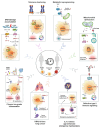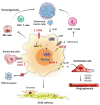Beyond polarization: macrophage senescence in immunoregulation and cancer therapy
- PMID: 40765820
- PMCID: PMC12320033
- DOI: 10.7150/ijbs.115921
Beyond polarization: macrophage senescence in immunoregulation and cancer therapy
Abstract
Cancer incidence is increasing globally, presenting significant health challenges due to its severe impact on morbidity and mortality. As a disease closely linked to aging, the prevalence of cancer is expected to increase with increasing age, underscoring the need for comprehensive research into its mechanisms and treatments. Macrophages, which are central to the immune system, play a paradoxical dual role in cancer progression. While they can suppress tumor growth, tumor-associated macrophages (TAMs) frequently facilitate tumor development and metastasis, a complexity that is further intricate by the aging process. As macrophages transition into senescent cells, they undergo changes, including shifts in cytokine profiles, reduced phagocytic activity, and altered metabolism. These senescent macrophages contribute to cancer progression by creating an immunosuppressive environment, promoting angiogenesis, and supporting tumor invasion. This review explores the intricate functions of senescent macrophages in cancer, highlighting their implications for tumor biology and their potential as therapeutic targets. We discuss strategies to manipulate senescent macrophages to enhance current cancer therapies, emphasizing the importance of understanding their mechanisms to advance cancer treatment.
Keywords: age-related diseases; cancer microenvironment; macrophage senescence; senescence-associated secretory phenotype (SASP); therapeutic targeting.
© The author(s).
Conflict of interest statement
Competing Interests: The authors have declared that no competing interest exists.
Figures




Similar articles
-
Advancements in Targeting Macrophage Senescence for Age-Associated Conditions.Aging Dis. 2024 Sep 14;16(4):2201-2236. doi: 10.14336/AD.2024.0720. Aging Dis. 2024. PMID: 39500353 Free PMC article. Review.
-
Macrophages at the crossroads of cellular senescence and cancer development and progression: Therapeutic opportunities and challenges.Pharmacol Ther. 2025 Aug 7;274:108906. doi: 10.1016/j.pharmthera.2025.108906. Online ahead of print. Pharmacol Ther. 2025. PMID: 40782901 Review.
-
Management of urinary stones by experts in stone disease (ESD 2025).Arch Ital Urol Androl. 2025 Jun 30;97(2):14085. doi: 10.4081/aiua.2025.14085. Epub 2025 Jun 30. Arch Ital Urol Androl. 2025. PMID: 40583613 Review.
-
An Epic Advancement in Targeting Macrophages for Cancer Therapy Approach.Curr Drug Deliv. 2025;22(6):732-745. doi: 10.2174/0115672018299798240403062508. Curr Drug Deliv. 2025. PMID: 38591208 Review.
-
Therapeutic effects of PDGF-AB/BB against cellular senescence in human intervertebral disc.Elife. 2025 Jul 16;13:RP103073. doi: 10.7554/eLife.103073. Elife. 2025. PMID: 40668091 Free PMC article.
References
-
- Siegel RL, Giaquinto AN, Jemal A. Cancer statistics, 2024. CA Cancer J Clin. 2024;74:12–49. - PubMed
-
- Zhang X, Yu S, Li X, Wen X, Liu S, Zu R. et al. Research progress on the interaction between oxidative stress and platelets: Another avenue for cancer? Pharmacol Res. 2023;191:106777. - PubMed
-
- Li S, Dong R, Kang Z, Li H, Wu X, Li T. Exosomes: Another intercellular lipometabolic communication mediators in digestive system neoplasms? Cytokine Growth Factor Rev. 2023;73:93–100. - PubMed
Publication types
MeSH terms
LinkOut - more resources
Full Text Sources
Medical
Research Materials

